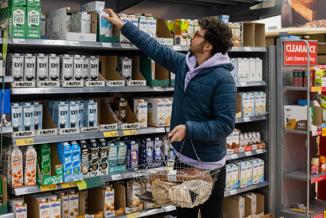The fashion retail industry, a sector characterised by complex global supply chains and rapidly evolving consumer demands, faces a critical juncture with the proposed Omnibus Directive.
This directive, aiming to ease administrative burdens by raising sustainability reporting thresholds, risks diluting the EU's ambitions and seems likely to create disparities within the fashion supply chain, potentially undermining the industry's burgeoning sustainability efforts. For those in the industry who choose to or must operate within the EU there are challenges ahead, but the fashion industry is, for distinct reasons, uniquely positioned to face these challenges down.
The fashion retail industry: A hotbed of sustainability challenges
The fashion industry, long notorious for its environmental footprint and social impacts, remains under intense scrutiny. From raw material sourcing to manufacturing, distribution, and end-of-life disposal, the sector grapples with a myriad of sustainability challenges:
- Complex and opaque supply chains: Fashion supply chains are often complex, involving numerous tiers of suppliers across diverse geographical locations. This complexity makes it difficult to fully trace and monitor environmental and social impacts in the required detail.
- Environmental degradation: The industry contributes significantly to water pollution, greenhouse gas emissions, and textile waste. Fast fashion models exacerbate these pre-existing problems even further by promoting overconsumption and rapid product turnover.
- Human rights violations: Labor exploitation, unsafe working conditions, and forced labour remain prevalent in some parts of the fashion supply chain even after the backlash to incidents such as Rana Plaza.
Set against these challenges are a number of developing issues with consumers and investors:
- Consumer demand for transparency: Despite national and supranational changes of position in relation to Diversity, Equality and Inclusion and Net Zero ambitions consumers continue to increasingly demand transparency and accountability from fashion brands regarding their sustainability practices.
- Regulatory pressures: Even though the focus in the American market may have shifted dramatically over the past few months it remains the case that the EU and most other countries remain committed to regulation. The CSRD and CSDDD, despite the proposed amendments, have already placed significant pressure on fashion retailers to improve their sustainability performance either because they are due to report or in anticipation of reporting requirements over the coming years.
The Omnibus Directive's impact on fashion retail: Exacerbating supply chain disparities
The proposed Omnibus Directive, will, if passed in its proposed form, remove some 80% of entities from the obligation to report. It seems that by raising reporting thresholds in this way existing disparities within the fashion supply chain are likely to be exacerbated. The larger retailers and bigger industry players will remain in a position where the have to report on their value chain whilst continuing to face the same data gap issues that had been anticipated. These issues are likely to be exacerbated by the fact that, whereas pre-amendment many in the supply chain would become eligible to have to report over the next few years and so had an ‘own interest’ reason for obtaining, collating and producing in a publishable form when it came to their environmental, social and governance data, that reason no longer exists.
Large fashion retailers, who might still be bound by CSRD and CSDDD, will face significant challenges in obtaining consistent sustainability data from their suppliers. These data gaps will hinder accurate assessments of supply chain risks and vulnerabilities as well as making reporting under the EU obligations much more difficult.
The proposed changes also seem likely to artificially create an uneven playing field; with larger retailers facing stringent reporting requirements and the associated costs while smaller suppliers are exempt. This seems likely to lead to competitive distortions and discourage voluntary sustainability efforts. It will also mean there are financial and practical advantages to growing a business to just below the threshold and expanding no further. The effect of this could be the splintering of the industry into smaller entities and have the contrary to intended effect of stymying growth.
Sustainability: A fundamental imperative, not just a marketing tool
For the fashion retail industry, sustainability and social responsibility has become much more than a marketing tool; it is a fundamental imperative for long-term viability. Whilst implementing sustainable practices may entail upfront costs, the long-term benefits are substantial:
1. Enhanced brand reputation and consumer loyalty
Consumers are increasingly drawn to brands that demonstrate genuine sustainability commitments.
2. Reduced operational costs
Sustainable practices, such as energy efficiency and waste reduction, can lead to significant cost savings.
3. Improved supply chain resilience
Diversifying sourcing and investing in sustainable supply chain practices can enhance resilience to disruptions.
4. Attracting and retaining talent
Employees are increasingly drawn to companies with strong sustainability values.
5. Access to sustainable finance
Investors are increasingly prioritizing companies with strong ESG performance.
6. Long term profitability
By creating a circular business model, and by reducing waste, and by improving brand reputation, profitability will increase.
Navigating the challenges: Potential solutions and mitigation strategies for fashion retail
To navigate the challenges posed by the proposed Omnibus Directive, the fashion retail industry must adopt a proactive and collaborative approach but there are perhaps some unintended consequences for this industry that might also be wise to consider and account for and not all of these are negative.
The first step in building a foundation which can withstand the, at present and for at least the next four years, changeable political climate relating to sustainability and ESG in general is, for larger entities, an early and proactive strengthening of supplier engagement. Although many large and SME level entities have been (one hopes) making preparations for the day when they are required to begin reporting. The Omnibus Directive may (and the key word is may as the Omnibus is by no means guaranteed to be passed unamended) at some unspecified point in the future mean they are no longer facing such an obligation but for present purposes most will have at least started looking into what is required and some may have even begun collecting relevant data from their supply chain.
For the larger entity, leveraging the fact that their smaller suppliers are, for current purposes, in the same position as ever and encouraging them to continue with this process notwithstanding what might be seen as cold feet by the EU, will be vital to ensure that the data can be available for the larger entity’s reports. The alternative (which may also need to be considered) would be to impose contractual obligations on suppliers, which whilst effective does not exactly make for happy relationships.
Alongside this capacity building is important. Large retailers must engage with their suppliers to help build their capacity for sustainability reporting and due diligence. This is linked to the above notion in that the larger retailer that wishes to maintain it is position as a leader in sustainability may need to invest in and assist the smaller entities in the supply chain to ensure that the necessary practices are adhered to and the necessary data is gathered.
For smaller entities, the exact opposite is true. Early relationship building with key buyers and the putting in place of the necessary systems (with their support if available or needed) will secure in many instances a ‘preferred provider’ status and assist the entity in maintaining its competitive edge.
This interaction between small, medium and large entities in the fashion retail ecosystem may well (not only in the context of fashion but perhaps because of the nature of the industry, more effectively), negate some of the less desirable “watering down” effects that campaigners are fearful of.
A further matter to consider, which is again specific to the fashion industry, is that notwithstanding the potential for the reduction in the strength of the bite from CSRD and CSDDD, there are other directives which will require much (but by no means all) of the required data is gathered in any event.
The Ecodesign for Sustainable Products Regulation (ESPR) will require, over the coming years, that garments and footwear is labelled with a Digital Product Passport (DPP) and whilst the exact criteria of what is to be included remains unclear one can be fairly certain that it will require garment and footwear manufacturers, retailers and those in the supply chain to obtain sustainability data and social data in order for it to be included in the DPP. There is surely scope for a race to the top when it comes to the level of detail and presentation of the included data.
As a result many have already begun investing in Traceability and Transparency Technologies (TTT). Implementing these technologies across the supply chain will help address data gaps but also means that, as might be seen after the Omnibus Directive is passed, those smaller entities in the supply chain will continue to be obliged to collect and provide the necessary data not by the big stick of government regulation but by the, by no means less effective, power of market forces.
There are other directives and regulations which, although not necessarily the same scope and depth as CSRD and CSDDD, will still require reporting. The Deforestation Regulation (leather) and the Conflicts Minerals Regulation (gold) are two examples of wider sustainability EU regulations which will have an impact on the fashion industry and its supply chains.
There are a number of other steps the industry, particularly the part that has strong links to Europe and deals with less ephemeral garments and items of footwear, may wish to consider:
1. Adopting industry-wide sustainability standards
Collaborating with industry stakeholders to develop and adopt standardized sustainability frameworks can promote consistency and comparability.
2. Prioritising materiality and risk-based approaches
Focusing on the most significant environmental and social impacts can help retailers prioritize their sustainability efforts.
3. Advocating for clear and consistent regulations
Engaging with policymakers to advocate for clear and consistent sustainability regulations that promote a level playing field.
4. Embracing circular economy principles
Shifting towards circular business models that prioritize reuse, repair, and recycling can reduce waste and environmental impact. For example repair services are now becoming particularly prevalent after having been available for a limited group of brands historically, Levi’s and various outdoor apparel brands have led the way on this with brands such as H&M, Uniqlo and Zara following in their footsteps.
5. Consumer education
Educating consumers about the importance of sustainable fashion choices can drive demand for sustainable products.
The path forward: A sustainable and prosperous fashion industry
The fashion retail industry has a unique opportunity to lead the way in environmental sustainability and social transformation notwithstanding the volte face seen in the USA in respect to these issues (in particular the dismantling of DEI in the USA by President Trump will be something the industry as a whole faces with concern) and the potential watering down of the flagship EU sustainability laws.
By embracing genuine sustainability practices and collaborating with stakeholders across the value chain, the industry can create a more sustainable and prosperous future for all.
But this is more important to this industry and this industry is uniquely positioned than others. Without progress being made, the Eurocentric, quality driven parts of the industry will find it increasingly hard to compete with the fast fashion websites. It is only be embracing, for example, DPP and supporting and encouraging their supply chain in taking the necessary steps to provide the information necessary, that they will be able to demonstrate a clear and powerful distinction between the transparency and traceability that discerning consumers will, even in a seemingly perpetual cost of living crisis, pay more for and the closed secretive practices of fast fashion who, with the best will in the world, will find it hard to legitimately engage in something like DPP.
Even with the proposed omnibus directive and the reduction (for which read extinguished) level of concern and interest in the USA, the importance of sustainability remains, and the companies that take the lead will be the ones who are most successful in the future, the ones who are able to sustain themselves for the mutual benefit of their owners, shareholders, staff, suppliers, and last but by no means least, artistic endeavour, even during difficult times.
Contact

Bill Cordingley
Barrister (Senior Associate)
bill.cordingley@brownejacobson.com
+44 (0)330 045 1000









































